AVADirect's Clevo X7200 Redux: AMD 6970M CF Takes the Crown
by Dustin Sklavos on June 2, 2011 3:05 AM ESTApplication and Futuremark Performance
While PCMark performance is expected to be a bit of a wash with the last X7200 we reviewed (the 990X is slightly faster than the "old" i7-980X, but the previous X7200 had two SSDs in a RAID 0), it's worth comparing the 990X's performance to a current Sandy Bridge mobile quad core if for no other reason than to see just how close they get.
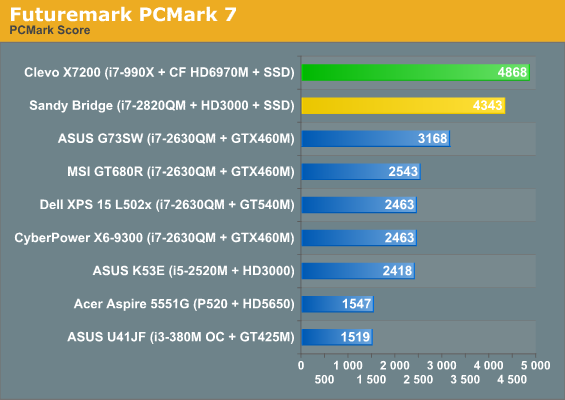
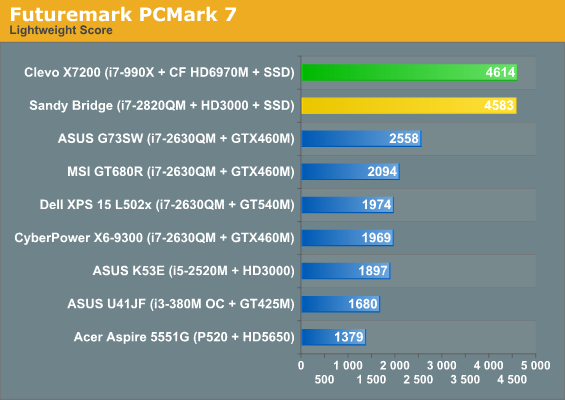
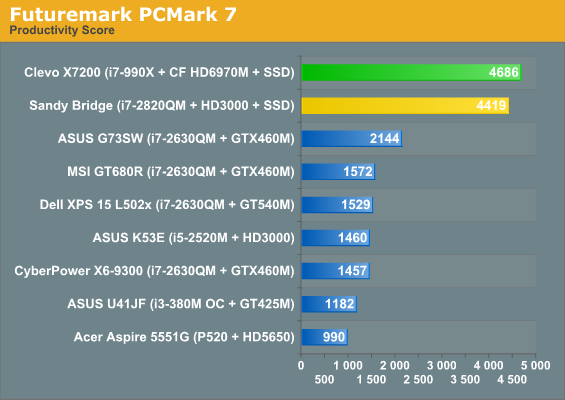
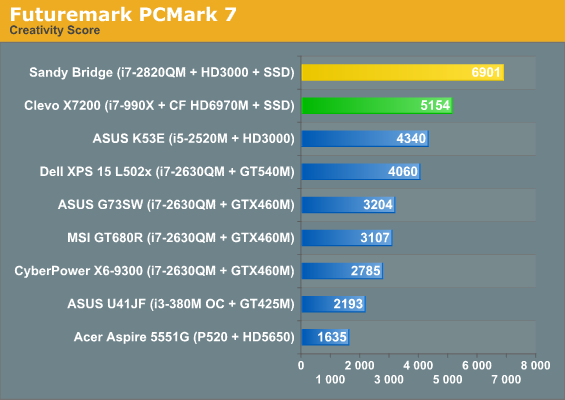
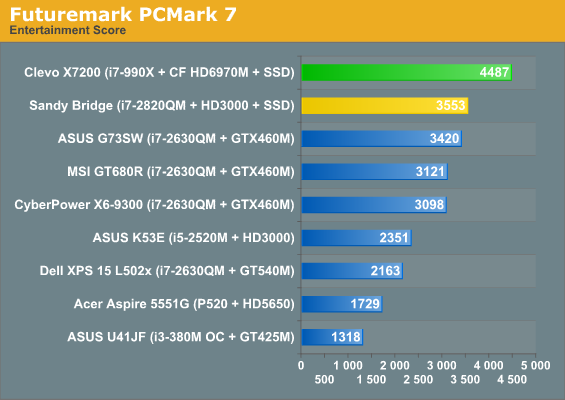
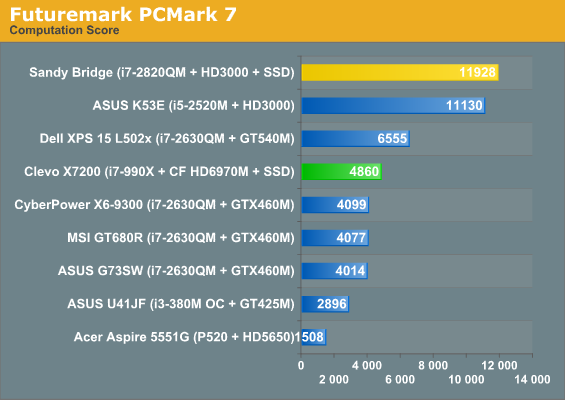

We'll start with a focus on PCMark 7, as an all-inclusive benchmark suite. We ran all of the available tests, and you can see how the focus shifts from multi-threaded to storage to GPU depending on what you're doing. Of particular interest is the Computation score, which leverages Intel's Quick Sync and thus gives the K53E and i7-2820QM a huge lead. (Strangely, the Optimus-enabled XPS 15 only seems to get partial credit for Quick Sync.) The only other test where the hex-core i7-990X fails to take the crown is in the Creativity suite, which again appears to favor the presence of Quick Sync.
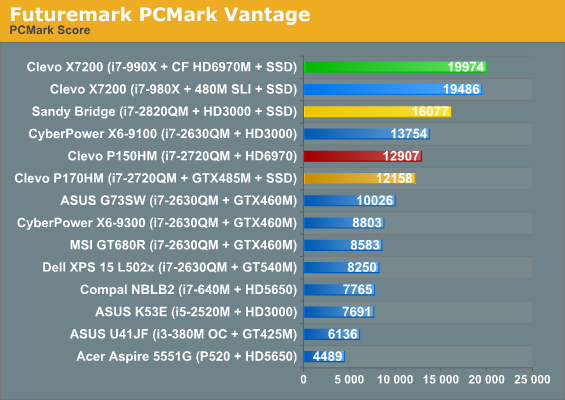
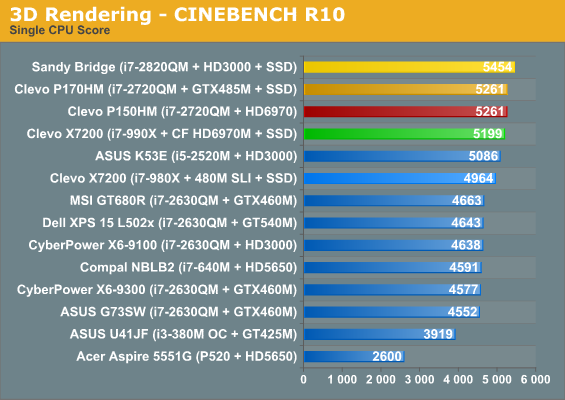

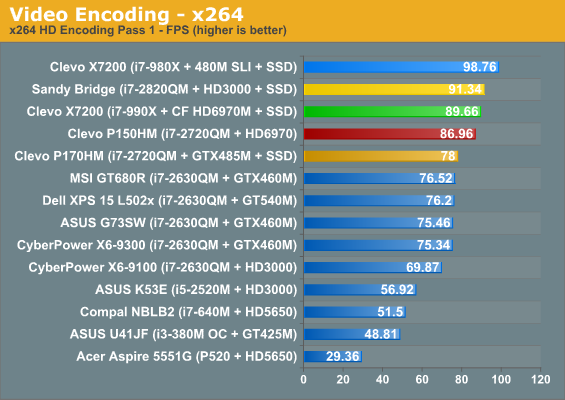
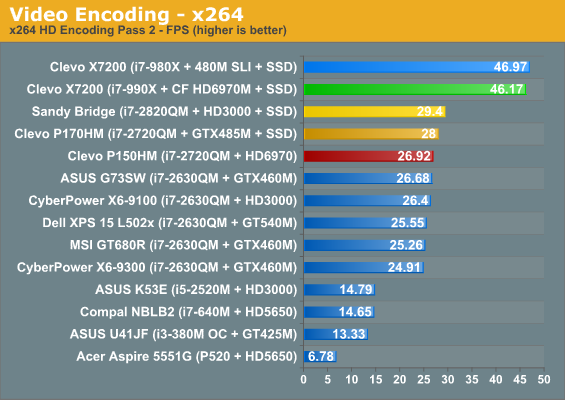
Our remaining applications fail to make use of Quick Sync, so the Gulftown CPUs return to prominence in multi-threaded workloads. The single-threaded Cinebench results are also worth pointing out, as they show the benefit of Sandy Bridge's extremely aggressive Turbo Boost states--even the dual-core SNB chips can come within striking distance of the i7-990X in such tests. In the other tests, the i7-2820QM puts in quite a show, and it will likely take Sandy Bridge E or Ivy Bridge to dethrone Gulftown for multi-threaded tasks.
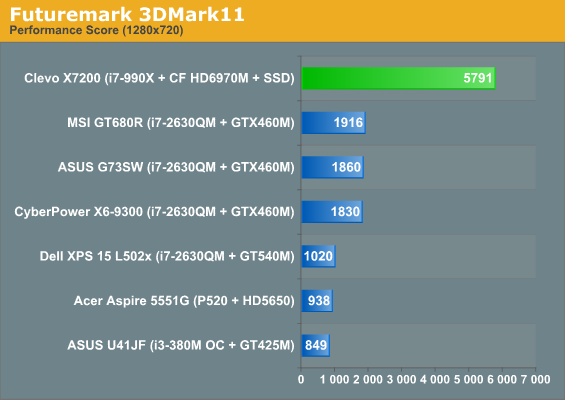
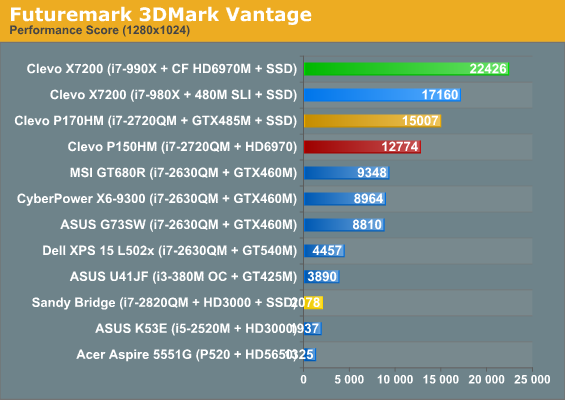
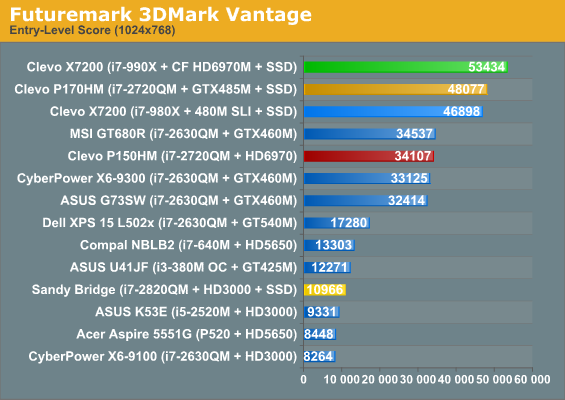
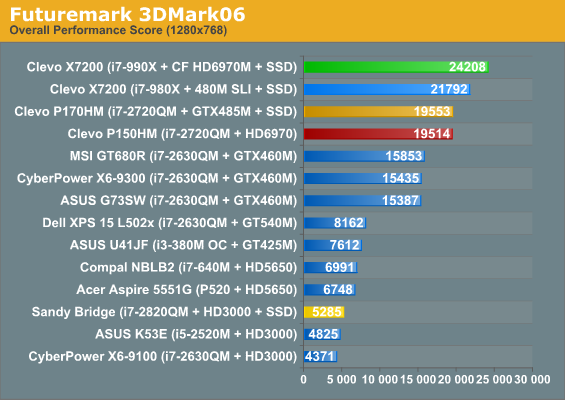
Unsurprisingly, the CrossFired Radeon HD 6970Ms thoroughly dominate in 3DMark. As the versions get newer, CrossFire also begins to scale more linearly until finally in 3DMark Vantage it practically doubles from a single 6970M. (3DMark 11 would be a similar situation, but we don't have results from the older version.) But you didn't come here to see how these ran in canned synthetic benchmarks, you want to see how they perform in real games.










44 Comments
View All Comments
FXi - Saturday, June 4, 2011 - link
http://forum.notebookreview.com/alienware-m17x/583...The driver problems that "don't exist anymore". Uninstall a driver and brightness doesn't work? Brand new notebooks that don't work off of stock drivers (which you already mentioned). Just crazy. And this is just the tip of the iceberg.
But people keep sayin' AMD drivers are "fine". In my book, this kind of thing isn't "fine", not even close.
JarredWalton - Monday, June 6, 2011 - link
You're looking at a specific implementation that's having problems. I've had plenty of issues with Alienware's custom drivers in the past, and I'll definitely agree issues crop up with some laptops and some drivers. The brightness issue (and ref drivers not installing) is something that I've seen with NVIDIA laptops as well.There's a reason the notebook drivers are about 50% larger than desktop drivers -- they have to have custom hooks into all the Fn keys, OSDs, and any other special utilities. So if you buy a brand new notebook with high-end hardware, yes, there's a reasonable chance you will experience driver teething issues. Again, I've had it happen with NVIDIA and AMD (as recently as the ASUS G73Jw, where right after I received a review sample NVIDIA came out with a new driver set, but it wouldn't install on the G73Jw; the next set a month or so later worked). In this particular instance, it's up to Alienware as much as AMD to fix the problem.
Anyway, I've been running AMD GPUs for the past four years on my primary desktops. Not entirely happy with every aspect, but drivers haven't been bad. Also, I stopped using CrossFire after running 5850 CF for a while; I don't miss it, because there were too many "oddities". Maybe it's my LCD, or maybe it's the hardware, or maybe it's the drivers, but I get a periodic flicker just using the PC on occasion. Maybe it's just that all high-end hardware is annoying on some level?
AmdInside - Thursday, June 2, 2011 - link
The battery life is hilarious. Wonder what the battery life would be life after a year of use. 5 minutes?shin0bi272 - Friday, June 3, 2011 - link
I know everyone loves to watch the bars go higher and higher for game tests but how about when you are testing a game with nvidia physx we get one round of tests with the physx TURNED ON? Its cool that amd cards do really well in metro2033 with physx off but how about we turn it on and see the scores then hmm?JarredWalton - Friday, June 3, 2011 - link
The only time I'd ever consider PhysX is if you are already running at more than acceptable frame rates. The 480M SLI can generally manage that, so I did test it in the previous X7200 review: http://www.anandtech.com/show/3970/3The scores aren't in the charts, but you can read the text at the bottom of the page. Anyway, I don't feel there's much point to enabling PhysX at low or medium detail, and probable not until you're running native resolution and high to very high detail. Metro 2033 is such a beast that you can't even enable all options (and stay above 30FPS) unless you're running something like desktop 560 SLI or better.
Rasterman - Friday, June 3, 2011 - link
I bought one of these as a desktop replacement, the idea was to use it as my desktop when working (I work at home), and then be able to take it on trips and not have to copy all of my work over and maintain two systems. Price is no object, but I am stickler for noise, and even at idle this thing was louder than any system I've ever had, add to that the size, weight, and dismal battery life and its ludicrous, I am surprised there is a market for this.I soon replaced it with a 2500K and am glad I did, I now have a 5GHz, 6950, 16GB, 256GB SSD system that is inaudible, and since it cost about $3000 less than this, I can buy a damn good notebook if I wanted to game on the go, I don't really need it though and will probably just get a really good all around machine, I only needed the desktop CPU this provides for my daily work as when I bought it sandy mobiles weren't out yet, now that they are out I don't understand the market for this at all.
There is not much of a CPU case to be made with the new sandy mobiles being so fast, and with graphics since battery life is so short you have to plug it in. The only real use of such a machine I can think of is someone who travels all the time and does a lot of gaming, maybe a high end game development machine? Even then with the noise it puts out its hard to concentrate while working on it.
whatthehey - Friday, June 3, 2011 - link
Perhaps your story is true, but if price is "no object", then why do you have a 2500K system overclocked to 5GHz? Why overclock (and to that extreme), and why not a 2600K? Buying a 6950 instead of a 6970 also seems like a price cutting measure. This sounds more like the post of an enthusiast trying to talk up the desktop world than an actual former owner of an X7200.But you're right about one thing: I am also surpirsed there is a market for this sort of notebook. I can understand mobile workstations that are certified for professional apps and come with Quadro GPUs. Such workstations are also built a lot better than any Clevo I've ever laid hands on. Paying $5000 (or even $3500) for what can only be considered a gigantic hunk of plastic with aluminum veneers, whose primary role would be mobile gaming? There's a reason very few LAN party regulars have this sort of system, and most of the other attendees tend to make fun of them. "You paid HOW much for a loud notebook that isn't as fast as my $2000 desktop!?"
dmichelstexas - Saturday, June 4, 2011 - link
Please consider providing specific information about the "mobile workstations that are certified for professional apps and come with Quadro GPU's". Where are they sold, who makes them, what specifically about their build quality is better than any Clevo you've ever laid hands on? Asking because there definitely is a user population of graphics professionals who are determined to resist the Mac and genuinely need this level of mobile performance. Battery life is of course a non-issue, as is size, weight, fan noise, gaming, cost, and so on. The only relevant considerations are performance and reliability. My laptop is the only "tool" I use to make a living, and if there is a better more powerful mobile computing solution I would sincerely appreciate any specific fact-based information you could provide. ThanksJarredWalton - Monday, June 6, 2011 - link
Dell Precision, HP EliteBook, and Lenovo ThinkPad W-series all come to mind. You won't get dual Quadro GPUs, but I can attest to the fact that the Precision M6500 and M6400 before it (http://www.anandtech.com/show/2957/) are built a LOT better than the Clevo units we've had. Dustin also reviewed an HP 8740w (http://www.anandtech.com/show/4049/) and found it to be an impressive if expensive piece of hardware. And really, if you're a professional running the type of software than needs a Quadro GPU, would you rather trust support to Dell/HP, or a much smaller company like Eurocom? I know which camp I'd be in, and while neither solution is a guarantee that everything will work, enterprise solutions usually give good support.Shinobi_III - Saturday, June 4, 2011 - link
Get a desktop pc maybe? Buy a UPS for it, and you'll have the same five minute backup power too...Or why not FOUR desktop PCs with similar equipment?
This isn't a portable computer, but it suffers all the problems of one, or will suffer
(durability etc) And it has crap battery life obviously.
I really don't get it.